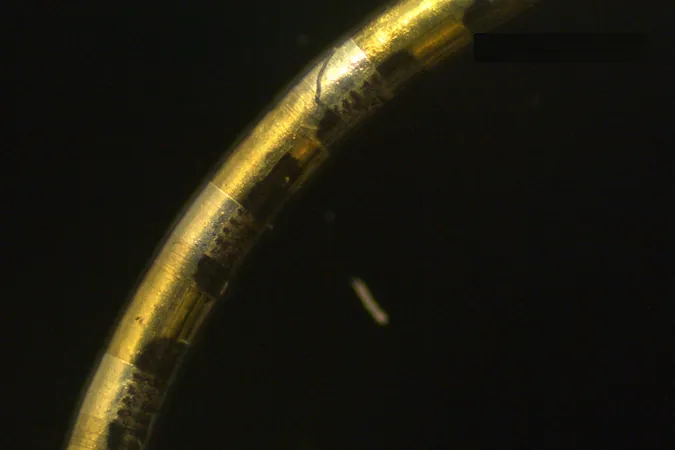
Revolutionizing Medicine: Meet NeuroString, the Tiny Fiber That Tracks Biological Activity Like Never Before!
2025-09-17
Author: Rajesh
Introducing NeuroString: The Future of Bioelectronics
Imagine a soft, hair-thin fiber capable of hosting thousands of electronic channels, ready to transform our understanding of the human body. Enter NeuroString, a groundbreaking invention designed to be implanted directly into the body to monitor everything from chemical levels to muscle and nerve stimulation.
A Leap into the Future of Wearable Tech
But that's not all - outside the body, NeuroString opens up a world of possibilities for smart fabrics, wearable tech, and soft robotics, even enhancing research on lab-grown tissues!
From Lab to Living Organisms: Early Trials
Researchers have already put NeuroString to the test, successfully monitoring pig intestines and tracking neuron activity in mice. Dr. James Dunn, a pediatric surgeon at Stanford, has been pioneering the growth of new intestinal tissues for children with short gut syndrome. With NeuroString, he now has the means to verify that this new tissue mimics normal intestinal function.
Collaboration Sparks Innovation: The Birth of NeuroString
Dunn collaborated with Dr. Zhenan Bao, a leading expert in skin-like electronics. Together, they developed a multi-channel biosensor that’s not only miniature but also remarkably biocompatible. This innovation could remain in the body for extended periods, ensuring patient comfort and safety.
Think Small: The Power of Miniaturization
Measuring just a quarter of a millimeter in diameter, NeuroString is an engineering marvel, designed to deliver potent data while being soft enough to avoid discomfort. Its high-density channels can sense neurochemicals, track gut movements, and even stimulate muscles.
Disrupting Traditional Tools: A Game-Changer for Medicine
Dr. Xiang Qian, co-director of Stanford’s eWear Initiative, emphasizes the need for these forms of bioelectronics in research and clinical settings, highlighting the limitations of current, bulky tools. NeuroString not only meets these needs but also promises to reshape how we approach neural modulation for treating severe pain.
Innovative Fabrication Techniques: Making the Future Possible
The development team created a clever roll-up fabrication technique, reminiscent of a Swiss roll, allowing for an incredible array of channels that can be deployed on an ultra-thin film. This unique approach ensures precise positioning and distribution of sensors, enhancing functionality.
Pioneering New Medical Frontiers
In practical trials, NeuroString has monitored the functioning of a pig’s intestine and observed neuron activity in a mouse over several months. Dunn describes the ability to track various biochemical functions simultaneously as potentially transformative for both research and clinical practice.
Imagining the Future: From Smart Pills to Automated Insulin Pumps
The potential applications are staggering. Imagine robotic pills navigating the gastrointestinal tract, or an implantable insulin pump delivering hormones automatically based on real-time blood sugar measurements. NeuroString could redefine medical diagnostics and treatment.
A New Era for Lab-Grown Organs
Bao is particularly excited about NeuroString’s applications in organoids—lab-grown tissues that mimic human organs. By embedding these sensors in organoids, researchers could gain unprecedented insights into their functions and biochemical processes.
The Future is Bright with NeuroString!
With plans to further enhance technology to include even more sensing capabilities, NeuroString represents a leap toward a world where medical interventions are less invasive and far more effective. Dr. Bao’s vision of monitoring and promoting organoid growth with this technology could redefine how we study and replicate human biology.



 Brasil (PT)
Brasil (PT)
 Canada (EN)
Canada (EN)
 Chile (ES)
Chile (ES)
 Česko (CS)
Česko (CS)
 대한민국 (KO)
대한민국 (KO)
 España (ES)
España (ES)
 France (FR)
France (FR)
 Hong Kong (EN)
Hong Kong (EN)
 Italia (IT)
Italia (IT)
 日本 (JA)
日本 (JA)
 Magyarország (HU)
Magyarország (HU)
 Norge (NO)
Norge (NO)
 Polska (PL)
Polska (PL)
 Schweiz (DE)
Schweiz (DE)
 Singapore (EN)
Singapore (EN)
 Sverige (SV)
Sverige (SV)
 Suomi (FI)
Suomi (FI)
 Türkiye (TR)
Türkiye (TR)
 الإمارات العربية المتحدة (AR)
الإمارات العربية المتحدة (AR)